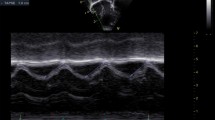Abstract
The aim of the study was to evaluate the left ventricular systolic function of newborns with asphyxia using tissue Doppler imaging (TDI). Newborns with a history of asphyxia were divided into severe and mild groups based on their Apgar scores; normal newborns without asphyxia served as the controls. Left ventricular ejection fraction (LVEF), fraction shortening (FS), and stroke volume (SV) were measured by M-mode echocardiography at 24, 48, and 72 h after birth. The peak systolic velocity of the anterior mitral valve leaflet (Sm wave) was measured with TDI. Cardiac troponin I (CTnI) was measured. The results revealed that the LVEF and FS of the severe asphyxia group at 24 h were significantly lower than those at later time points (P < 0.01). These parameters were also significantly lower than those of the mild and control groups (P < 0.01). SV was not significantly different among the three groups. Sm wave of asphyxia groups was significantly lower than that of control group (P < 0.001). In the severe asphyxia group, Sm wave at 24 h was significantly lower than that at 48 or 72 h (P < 0.001). CTnI values of the severe asphyxia group were remarkably higher than those of the other two groups (P < 0.01). The findings of this study indicate decreased left ventricular systolic function of newborn children after asphyxia. Sm by TDI is a more sensitive indicator of left ventricular systolic function than LVEF, FS, or SV by M-mode echocardiography.






Similar content being viewed by others
References
Alam M, Witt N, Nordlander R et al (2007) Detection of abnormal left ventricular function by Doppler tissue imaging in patients with a first myocardial infarction and showing normal function assessed by conventional echocardiography. Eur J Echocardiogr 8:37–41
Ammann P, Naegeli B, Schuiki E et al (2003) Long-term outcome of acute myocarditis is independent of cardiac enzyme release. Int J Cardiol 89:217–222
Atasay B, Arsan S (2003) Organization of neonatal care services and its importance. J Perinat Med 31:292–294
Bai XL, Han YK, Xu CX (1994) Early evaluation of heart function after neonatal asphyxia. Chin J Pract Pediatr 9:93–95 (In Chinese)
Cao HY, Meng FH, Li JG (2000) Study of multiple organs hemodynamics and cardiac functions of neonates with asphyxia. Chin J Ultrasound Med 16:37–39 (in Chinese)
Cao Y (2004) Resuscitation of neonatal asphyxia. New Med 38:46–48 (in Chinese)
Gorcsan J, Gulati VK, Mandarino WA et al (1996) Color-coded measures of myocardial velocity throughout the cardiac cycle by tissue Doppler imaging to quantify regional left ventricular function. Am Heart J 131:1203–1213
McDicken WN, Sutherland GR, Moran CM et al (1992) Colour Doppler velocity imaging of the myocardium. Ultrasound Med Biol 18:651–654
Gill AB, Weindling AM (1993) Echocardiographic assessment of cardiac function in shocked very low birth weight infants. Arch Dis Child 68:17–21
Ichihashi K, Yada Y, Takahashi N et al (2005) Utility of a Doppler-derived index combining systolic and diastolic performance (Tei index) for detecting hypoxic cardiac damage in newborns. J Perinat Med 33:549–552
Lawn JE, Wilczynska-Ketende K, Cousens SN (2006) Estimating the causes of 4 million neonatal deaths in the year 2000. Int J Epidemiol 35:706–718
Liu X, Qiu YP, You SR (2000) Echocardiography evaluation of right ventricular function for post-asphyxia newborn infants. China JMIT 16:454–455 (in Chinese)
Moraru L, Cimponeriu L, Tong S et al (2004) Characterization of heart rate variability changes following asphyxia in rats. Methods Inf Med 43:118–121
Ranjit MS (2000) Cardiac abnormalities in birth asphyxia. Indian J Pediatr 67:S26–S29
Waggoner AD, Bierig SM (2001) Tissue Doppler imaging: a useful echocardiographic method for the cardiac sonographer to assess systolic and diastolic ventricular function. J Am Soc Echocardiogr 14:1143–1152
Walther FJ, Siassi B, Ramddam NA (1998) Cardiac output in newborn infant with transient myocardial dysfunction. J Pediatr 107:781–785
Zhu XP, Zhang RX, Huang YP (1999) Clinic value of cTn1 in evaluation of myocardial damage after asphyxial newborn. Chin J Pract Pediatr 14:667–668 (in Chinese)
Acknowledgments
This work was performed at Jin Hua Municipal Central Hospital, Jin Hua City, Zhejiang Province, China. The work was sponsored by health department grants from Zhejiang Province.
Author information
Authors and Affiliations
Corresponding author
Rights and permissions
About this article
Cite this article
Wei, Y., Xu, J., Xu, T. et al. Left Ventricular Systolic Function of Newborns with Asphyxia Evaluated by Tissue Doppler Imaging. Pediatr Cardiol 30, 741–746 (2009). https://doi.org/10.1007/s00246-009-9421-6
Received:
Revised:
Accepted:
Published:
Issue Date:
DOI: https://doi.org/10.1007/s00246-009-9421-6




